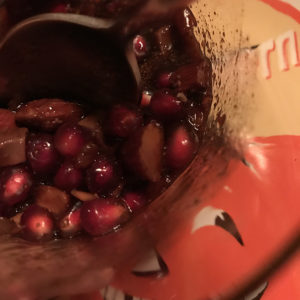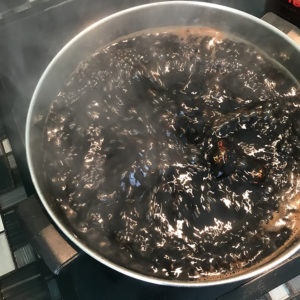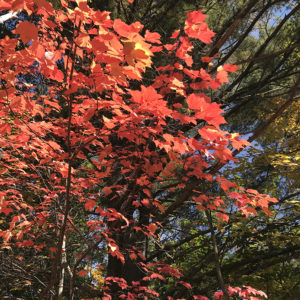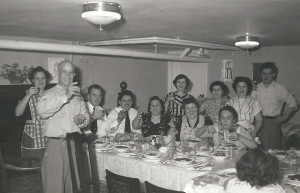Seth and I and our nephew descended upon my family home this past Saturday to visit my mom and sister for a Family Work Day. There were weeds to pull and lawns needing autumn fertilizer and there were rotted boards to replace and all manner of things to do, things that had been piling up for months. Mom, while we all did these things, cooked. She made us eggplant parmigiana for lunch… and she had a pot of mosto cotto brewing on the stove. U cutto we call it in our Lucerine dialect: “oo coot-oh.” It is a syrupy concoction that we use in all sorts of sweets at the end of the year. It’ll show up in Christmas cookies, and it made an appearance at All Souls Day in a dessert distinct to my grandparents’ region of Puglia that is made just for that night. My grandparents used to pour it over freshly fallen snow as a treat for the kids. It is, at its most basic, what’s left of the grape must after winemaking, boiled down with sugar to a reduction. It takes all day to cook, filling every corner of the house with its aroma, and it is prized by my people, its own sort of black gold.
U cutto would traditionally be made around the Nativity of Mary, which was in September, or around Martinmas, which is today. My mom wasn’t even thinking about that, though: it was just time to make it. It’s autumn, and her thoughts have begun shifting to holiday preparations, and making u cutto is a big preparation, and a time-consuming one. I suspect her making it yesterday was more instinctual than anything else: it is November, and this is what we do in November… a culinary tradition handed down from time immemorial.
Martinmas has a lot to do with wine, for it is time for the first tasting of the wine that was put up to ferment in September. It’s also when the young new Beaujolais wines of France are released. This has to do with timing and with St. Martin of Tours, who lends his name to Martinmas, being a patron saint of winemakers. It is also the last big religious feast before advent, that time of preparation for Christmas. In earlier days, advent was a season of fasting, and so Martinmas was a very big deal, a chance to indulge. Traditional Martinmas foods include goose and turkey, and also chestnuts and very hard biscotti, some of which are baked not just twice but three times. The extra baking makes them hard as rocks, but with good reason: Biscotti di San Martino are meant to be dunked in that new wine that we’re drinking on his day.
In the parts of Europe that most thoroughly celebrate St. Martin’s Day, it is often a time of warmer weather, the last bit of it before the full onset of winter. Kind of like Indian Summer in America, it’s known in Italy, for instance, as l’estate di San Martino (St. Martin’s Summer). But this mild weather tends to be fleeting. Colder nights lie ahead and with Martinmas we find ourselves, by traditional reckoning of time, at the natural start of winter. It is, until Yuletide, a time of increasing darkness. The living world continues its process of shutting down and receding into itself: going underground. Trees are no longer growing above, but roots below the surface still are growing. And so the connexions are strong, these darkening days, between the world of the living and the underworld of the dead.
Of course we honored these days of the dead at the start of the month with Halloween and All Saints and All Souls. But the connection of Martinmas to the days of the dead is just as strong, through memory. Before the change to the Gregorian Calendar, the 11th of November was Samhain, the Celtic New Year. Another name for Martinmas is Hollantide, and just as Halloween is a corruption of the words All Hallow’s Eve, so is Hollandtide, which comes from Hallowtide: the time of the sacred, the holy––those who have gone before. Many of our contemporary Halloween traditions come out of Hollantide traditions: the carving of turnips (replaced by pumpkins here in America) into Jack o’Lanterns and the going door to door in search of soul cakes, which has evolved into the trick-or-treating we know today. The day is also a traditional weather marker: If ducks do slide at Hollantide, At Christmas they will swim. / If ducks do swim at Hollantide, At Christmas they will slide. / Winter is on his way / At St. Martin’s Day.
Finally, it is, of course Veterans Day, when we honor all who have served in the military. The day was formerly known as Armistice Day, for it was on Martinmas in 1918 that the treaty ending what would later be known as World War I was signed. The day is known as Remembrance Day in many places, but here in the US, Veterans Day became the day’s official name in 1954.
St. Martin also was a veteran. He served in the Roman army, until his conversion to Christianity and to pacifism, for which he was imprisoned. Upon his release, he went to France and founded a monastery. The best known legend about good St. Martin is his happening upon a shivering drunken man on a cold winter’s day. Martin tore his own cloak in two and gave one half to the drunken man to warm him. The legend makes St. Martin a patron saint not just of winemakers, but also those who love wine (including those who love it too much).
And so we continue turning inward at this time of year, gathering in, preparing for winter. What’s a good way to mark this Martinmas evening? Certainly with wine. Light a fire while you’re at it. The Celts would have lit huge bonfires on Samhain to welcome in the new year, and in our case, a small celebration involving a fire in the hearth or in the fire pit in the back yard is just as good, made even better with mulled wine and good company. Good St. Martin himself would have it no other way… especially if the year’s new cutto––the mosto cotto––is already brewed and bottled and being kept cool in the fridge. Our time of Christmas preparation lies ahead. For now we pause and delight in the small things of this earth.
Images: At top, Cici Cutto (pronounced “chee-chee coot-oh”), the traditional dessert for I Morti, or All Souls Night, that comes from my grandparents’ city of Lucera in Italy. It is a strange concoction of cooked whole wheat berries, pomegranate, chopped toasted almonds, and chopped chocolate. U cutto, infused with cloves and cinnamon, is poured over it. Second photo: Mamma’s pot of u cutto simmering on the stove last Saturday; it’s now packed in jars in the refrigerator, ready for use. She makes it just once each year.
COME SEE US!
We’re popping up at quite a few local South Florida venues in November & December!
Sankta Lucia Festival & Julbasar (Christmas Bazaar)
Saturday November 23 from 11 AM to 3 PM
First United Methodist Church
625 NE Mizner Boulevard in Boca Raton
Our pop-up shop will focus on traditional European advent calendars and advent candles, plus handmade Christmas ornaments and decorations from Sweden, as well as our full line of Shaker herbs & teas and more (like my mom’s famous candy wreaths). It’s a beautiful event, complete with a Lucia with a wreath of candles on her head! Brought to you by SWEA, the Swedish Women’s Educational Association.
Harvest Makers Marketplace
Sunday November 24 from 10 AM to 4 PM
Florida Atlantic University
Boca Raton
We’ll be transitioning toward Christmas with a pop-up shop of traditional German advent calendars and advent candles from England, plus handmade Christmas ornaments and decorations from Germany, Sweden, and Mexico and our full line of Shaker herbs & teas and more (like my mom’s famous candy wreaths). Plus there’s live music almost all day: The Lubben Brothers from 11 AM to 1 PM, Rio Peterson from 1 to 4 PM. It’s going to be a good one!
Christkindlmarkt
Saturday & Sunday December 7 & 8 (2 to 9 PM on Saturday; 1 to 8 PM on Sunday)
at the American German Club
5111 Lantana Road in Lake Worth
Convivio Bookworks will be part of this old time German Christmas market in suburban Lake Worth. At our booth you’ll find traditional handmade German Christmas items, and we’ll throw in some other handmade items from our Swedish and Mexican collections, too, as well as Shaker herbs & teas, some letterpress goods, and my mom’s famous handmade candy wreaths.
More markets to come beyond this, too!



